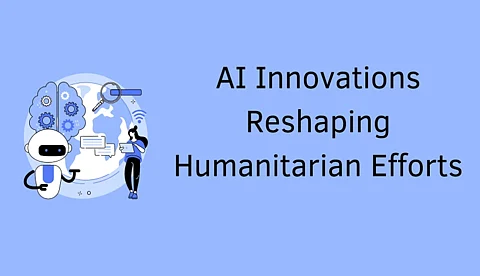

In today’s digital transformation era, Artificial Intelligence (AI) is revolutionizing the landscape of humanitarian aid, bringing unprecedented precision, efficiency, and predictive capabilities to crisis response. From optimizing disaster relief efforts to enhancing healthcare accessibility and streamlining resource allocation, AI-driven solutions are reshaping how humanitarian organizations operate. Technology leader Deepak Bajaj explores the groundbreaking innovations that are redefining humanitarian work, demonstrating how AI creates a lasting impact in emergencies and beyond. This article delves into the transformative role of AI in humanitarian efforts and its potential to drive meaningful change where it is needed most.
Predictive analytics is one of AI's most profound applications in humanitarian efforts. Machine learning models now process vast datasets, including satellite imagery and meteorological data, to accurately forecast natural disasters. Recent advancements have improved flood detection rates by up to 85%, allowing aid organizations to deploy resources proactively rather than reactively. AI-powered forecasting models also enhance cyclone trajectory predictions, improving response times and evacuation strategies to mitigate loss of life and infrastructure damage. Organizations like NASA and the World Food Programme are leveraging AI-driven early warning systems to anticipate crises and improve disaster preparedness.
AI has ramped up emergency response strategies with real-time data and automation. AI image recognition applications can evaluate areas affected by disasters 40 times faster than the normal methods. These systems utilize satellite and drone imagery to identify damage hotspots, propelling rapid decision-making and efficient resource allocation. In evacuation situations, AI-based routing mechanisms adjust in real time to prevailing road conditions, enabling these plans to decrease evacuation times by 45% compared to conventional plans. Disaster response tools driven by artificial intelligence have been employed by the Red Cross and FEMA to fast-track relief interventions and optimize resource deployment.
Humanitarian supply chains have witnessed remarkable improvements with AI-driven optimization models. Machine learning algorithms analyze logistical patterns, reducing delivery bottlenecks by 41% and minimizing delays in critical aid distribution. AI-enhanced inventory systems have achieved a 31% reduction in stockouts and a 25% increase in efficient inventory turnover. This precision ensures that essential resources, including medical supplies, food, and water, reach the most vulnerable populations without waste or misallocation.Organizations like UNICEF and Doctors Without Borders are leveraging AI to streamline supply chain management and enhance operational efficiency.
Biometric systems that are powered by AI have changed the face of refugee aid and management, with registration speeding up by 58% while identity verification is made 94% accurate. Such innovations smoothen the registration process and ensure that assistance is rendered not only speedily but securely to displaced persons. AI fraud detection tools have also enhanced verification rates of documents at 91% decreasing the incidence of disputes related to identities, and strengthening confidence in humanitarian assistance programs.
AI-powered diagnostic systems have lent an effective hand to healthcare delivery in crisis zones. AI-assisted remote diagnostic platforms process patient data with an accuracy rate of 88.5%, dramatically improving early disease detection and strategies for medical intervention. AI-enhanced telemedicine solutions have improved access to specialist consultations by 64.8% in underserved areas. Machine learning algorithms in maternal healthcare have achieved 89.1% accuracy in identifying high-risk pregnancies and have brought forth early medical intervention.
The application of A.I. in this field has many advantages, but it is fraught with challenges. One of the most significant concerns has been algorithmic bias; according to studies, the accuracy of such systems can differ by as much as 26 percent across demographics. Regular audits and bias mitigation strategies have instead been put in place for equitable outcomes. Among them is persistent data privacy issues. For many, there is still a struggle to implement this requirement globally. The new range of technologies that privacy-preserving A.I. developers use is differential privacy and federated learning, which help protect sensitive humanitarian data.
However, humanitarian fieldwork presents unique challenges to the adoption of AI owing to limited infrastructures, resource shortages, and connectivity issues, with network reliability hovering around 54.7% in remote regions. Investing in mobile AI models, low-power computing, and decentralized networks will act as catalysts in making AI more applicable to resource-poor crisis environments.
AI's undertaking in humanitarianism will continue to evolve and will include, but will probably not be limited to, growth in transparency, accountability, and human rights. Explainable AI is trending up, while cross-fertilization between researchers and policy makers would enable governance frameworks for practical application. Ethics in utilizing AI, ladies and gentlemen, will be a great deal toward extending and maximizing the human life-saving potential in crisis response and during aid.
In conclusion, there is no question that AI transforms humanitarian operations into ones in which responses to disasters, access to health care, and distributions of relief will work with almost a superhuman efficiency. On the other hand, success here is dependent on the conscientious application of the technologies, ongoing reductions in bias, and structural improvements to assure equitable access. Indeed, as Deepak Bajaj comments, AI would show its true promise through the balancing act performed while harnessing technological capabilities with ethical considerations, ensuring that humanitarian AI serves its core purpose-increasing life prospects and alleviating misery in times of crisis.
